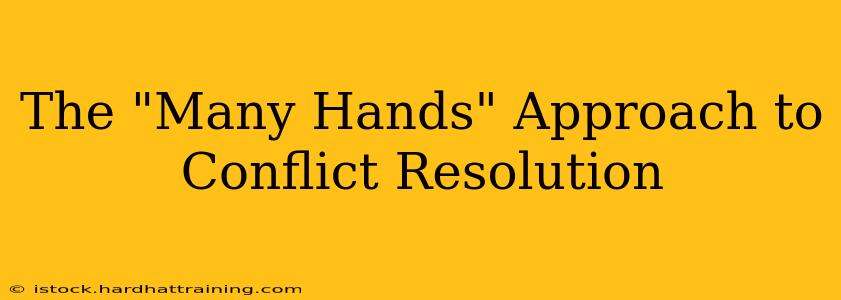Conflict is inevitable in any group setting, whether it's a family, workplace, or community. Traditional approaches often focus on individual solutions, pitting opposing sides against each other. However, a more effective and sustainable method involves a "many hands" approach – a collaborative strategy that leverages the collective wisdom and resources of all stakeholders to find mutually beneficial resolutions. This approach fosters empathy, understanding, and a shared sense of ownership in the outcome.
What is the "Many Hands" Approach to Conflict Resolution?
The "many hands" approach shifts the focus from individual blame or fault-finding to a collaborative problem-solving process. It recognizes that conflicts often arise from differing perspectives, needs, and values. Instead of seeking a "winner" and a "loser," it aims to find solutions that address the concerns of everyone involved. This involves actively engaging all participants in identifying the root causes of the conflict, brainstorming potential solutions, and collaboratively selecting the best course of action. Think of it as building a bridge instead of digging a trench between opposing sides.
How Does the "Many Hands" Approach Work in Practice?
The implementation of the "many hands" approach requires a structured process. This generally includes:
-
Identifying Stakeholders: The first step is to clearly define all individuals or groups impacted by the conflict. This ensures everyone with a stake in the outcome has a voice.
-
Creating a Safe Space: A crucial element is fostering a safe and inclusive environment where participants feel comfortable expressing their perspectives without fear of judgment or retribution. This may involve establishing ground rules for respectful communication.
-
Collaborative Problem-Solving: This involves open communication, active listening, and brainstorming sessions. The goal is to identify the underlying issues driving the conflict, not just the surface-level symptoms.
-
Developing Mutually Acceptable Solutions: Once potential solutions are identified, the group works collaboratively to choose the option that best addresses everyone's needs and concerns. This often involves compromise and negotiation.
-
Implementing and Monitoring: Once a solution is chosen, a plan for implementation is developed and agreed upon. The progress is then monitored to ensure the solution is effective and adjustments are made as needed.
What are the Benefits of the "Many Hands" Approach?
The benefits extend beyond simply resolving a specific conflict. This approach fosters:
-
Increased Ownership: When everyone participates in finding a solution, they are more likely to feel a sense of ownership and responsibility for its success.
-
Improved Communication: The process encourages open communication and active listening, leading to better understanding between parties.
-
Enhanced Collaboration: It fosters a culture of collaboration and teamwork, which can be beneficial in future conflicts.
-
Sustainable Solutions: Solutions developed collaboratively are more likely to be sustainable because they address the underlying causes of the conflict.
-
Strengthened Relationships: The process can actually strengthen relationships by fostering empathy and understanding between individuals or groups.
How Does the "Many Hands" Approach Differ from Traditional Methods?
Traditional methods often rely on mediation or arbitration, where a neutral third party facilitates a resolution. While these methods can be effective, the "many hands" approach empowers the stakeholders to take ownership of the process and the outcome. It avoids the potential power imbalance inherent in traditional methods where a mediator or arbitrator ultimately decides the solution.
What are Some Examples of the "Many Hands" Approach?
The "many hands" approach can be applied to various conflict situations:
-
Workplace Disputes: Resolving disagreements between employees through team meetings and collaborative problem-solving.
-
Community Conflicts: Addressing neighborhood disputes through community forums and participatory decision-making.
-
Family Conflicts: Resolving family disagreements through family meetings and open communication.
-
International Relations: Negotiating peace agreements through multilateral discussions and collaborative problem-solving.
Is the "Many Hands" Approach Always the Best Solution?
While the "many hands" approach offers significant advantages, it’s not always the most appropriate method. In situations involving significant power imbalances, abuse, or safety concerns, a more structured approach with a neutral facilitator may be necessary. The suitability of the method depends on the specific context of the conflict.
By embracing the "many hands" approach, organizations and communities can transform conflict from a destructive force into an opportunity for growth, learning, and strengthened relationships. The key is to foster a culture of collaboration, empathy, and shared responsibility.
